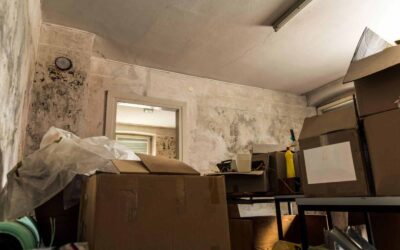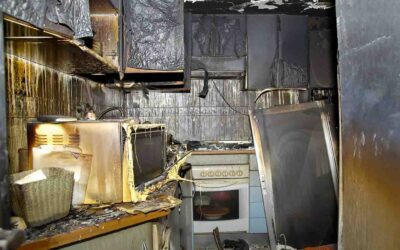Mold is something no homeowner wants to see. But when you live in a rainy climate like Oregon and Washington, mold in houses is a common problem. It’s important to know that many household molds can cause health problems, but how can you tell which type of mold is present in your home?
Let’s take a look at five of the most common types of mold found in Oregon and Washington houses, their potential health risks, and how you can effectively remove mold from your home and minimize mold infestations in the future.
1. Stachybotrys chartarum
Characteristics: One dangerous type of mold that can grow in homes is Stachybotrys chartarum. S. chartarum is dark greenish-black with a slimy texture. It starts as small dark spots that spread and grow larger over time. It frequently has a musty odor.
- chartarum typically grows on drywall, wood, bathroom surfaces, and windowsills. It thrives in warm, damp environments and frequently grows in areas that have sustained water damage.
Health Risks: S. chartarum is one of the most dangerous species of household mold, as it is toxic and can cause many physical symptoms. Prolonged exposure to this mold and its spores can lead to respiratory issues, coughing, sneezing, headaches, fatigue, and even neurological symptoms. Children and those with preexisting respiratory conditions are particularly vulnerable.
2. Alternaria
Characteristics: Alternaria thrives in damp, humid areas inside your home and typically appears as large brown spores in velvety patches. It is most commonly found in showers, bathtubs, and under kitchen or bathroom sinks—places where there is a lot of water. However, it can also grow on walls, windows, and fabrics that have been exposed to moisture.
Health Risks: Alternaria is one of the most common fungal allergies. Typical allergic reactions include sneezing, coughing, itchy eyes, and congestion. Most people are not allergic to Alternaria and may not show symptoms, even when mold is present in the home. However, prolonged exposure within your home can cause asthma and allergies to develop or worsen.
3. Aspergillus
Characteristics: Aspergillus actually encompasses a large family of molds. Depending on the species, this mold can appear green, black, or brown. Many species are harmless, but others can cause serious health problems. Aspergillus is most frequently found in damp areas of the home or within your home’s HVAC system.
Health Risks: Most people’s immune systems can handle this group of molds with no trouble. However, for people with asthma or those who are immunocompromised, Aspergillus spores can lead to allergic reactions, lung infections, or a severe fungal infection known as Aspergillosis.
4. Cladosporium
Characteristics: Cladosporium typically grows in soft patches or spots and can appear in shades of green, brown, or black. It can commonly be found on walls, carpets, fabric, wooden furniture, window sills, and HVAC vent covers. Darker-colored Cladosporium can sometimes be mistaken for Stachybotrys chartarum. It’s best not to take chances, however. Contact a professional to help you identify and remove the mold.
Health Risks: Some people may have allergic reactions to Cladosporium, experiencing symptoms such as sneezing, coughing, congestion, or itchy eyes. In some cases, reactions can be more serious, such as severe asthma attacks and sinusitis.
5. Chaetomium
Characteristics: Chaetomium spores are large, oblong, and dark brown. They prefer damp or water-damaged surfaces, particularly wood, drywall, baseboards, paper, and carpets. They frequently give off a musty odor.
Health Risks: Chaetomium is one of the most dangerous mold groups to humans and should be dealt with as soon as it is detected. Exposure can lead to severe allergic reactions, respiratory infections, skin infections, or immunological issues, such as Chronic Inflammatory Response Syndrome (CIRS). More serious symptoms, such as seizures and memory loss, have also been linked to Chaetomium.
What Should I Do If My Home Has Mold?
Many common molds look similar, making it difficult for most homeowners to identify the exact type of mold in their home. However, all household molds are potentially dangerous for your family’s health and should be removed as soon as possible.
Due to the health risks that mold presents, it’s always best to call in professionals. An inspector will be able to inspect your home and safely assess what type of mold is present and how far it has spread. An expert mold removal company can then begin the process of mold remediation.
Mold remediation goes above and beyond simply cleaning visible mold from surfaces. At Biodynamic, our team contains mold-affected areas and carefully removes damaged materials that cannot be remediated. Then we clean and disinfect all remaining affected surfaces with antimicrobial solutions. We also identify and ensure the root cause of the mold problem—typically, water damage or high humidity levels—is repaired.
The remediation process gets rid of mold from your home and helps prevent future issues.
How Can I Prevent Mold in My Home?
It is impossible to keep a house completely mold free. However, there are several steps you can take to minimize the risk of mold growth in your home.
All household mold species have one thing in common: they thrive in damp or humid environments. Mold prevention centers around controlling and regulating moisture levels in your home.
Oregon and Washington experience many days of rainfall each year, leading to a damp climate for most of the year. Using a dehumidifier can help keep your home’s humidity stable. You should also keep bathrooms and kitchens well-ventilated to reduce humidity levels. Make sure the vents lead to the outside of your home.
Regular maintenance and inspections are crucial to catching mold growth early on. Frequently check areas prone to mold, such as bathrooms, kitchens, attics, crawl spaces, and around sinks. Fix leaks and address any water damage immediately.
To reduce the number of mold spores in your home, clean with a vacuum equipped with a HEPA filter, and replace your home’s air filters regularly to keep your air fresh and clean.
Keep Your Family Safe From Household Molds
As an Oregon or Washington homeowner, it’s crucial to understand the common types of molds in houses and the health risks they pose to you and your family. If you’ve found mold in your house, it’s important to get it removed as soon as possible.
Biodynamic is the best in the business for mold removal in Oregon and Washington. Our non-toxic mold remediation and treatment process ensures your home is once again safe for you and your family. Contact Biodynamic today and let us help give you the peace of mind you deserve.


